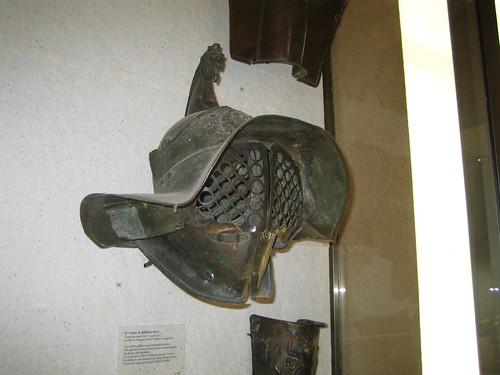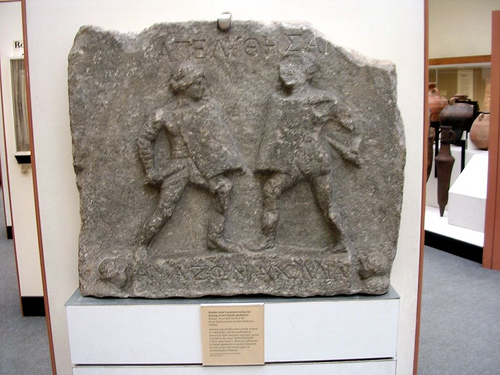Attribution: hsivonen Key Dates 75 This helmet was probably used in processions at the gladiatorial games at Pompeii, and was made shortly before the destruction of the city by Vesuvius’ eruption in 79 AD. The shape of the visor is typical of the period. It was given by Ferdinand IV of Naples to Napoleon, then First Consul, in 1802, and was transferred to the Louvre in 1892. This gladiator’s helmet is made of bronze, decorated with embossing and with silver-plating; it shows a griffin on the crest, and a Gorgon’s head on the front of the helm. It has a…
-
-
A Housing Crisis During the rule of Augustus from 27 BC to 14 AD, about 750 years after Rome was founded, the city’s population had ballooned to one million people. The hub of the Roman empire had transformed itself from its origins as a small agricultural community into the biggest city the world had ever known. It wasn’t until London, as hub of the British Empire, grew to one million in the mid-nineteenth century that there would be another city to equal the size of ancient Rome. However, the infrastructure and housing of Rome before the rule of Augustus was…
-
The legendary Ninth Legion – Legio IX Hispana (The “Spanish Legion”) – was one of the oldest and most feared units in the Roman army by the early 2nd century AD. Raised by Pompey in 65 BC, it had fought victorious campaigns across the Empire, from Gaul to Africa, Sicily to and Spain and Germania to Britain. No one knows for sure why, but sometime after 108/9 AD, the legion all but disappeared from the records. The popular version of events – propagated by numerous books, television programmes and films – is that the Ninth, at the time numbering some…
-
For any solider fighting wars away in foreign lands, letters to and from family and loved ones take on enormous resonance and importance. We’ve all seen the TV and movie versions of army life in the world wars, in which the handing out of letters is a ritual frought with excitement, emotion, and rivalry. The same situation was probably played out thousands of years earlier, as some remarkable ancient letters attest. While the first letters ever written were probably cuneiform imprints onto clay tablets, penned in Mesopotamia and Egypt, by the time the Roman civilization began to expand around the…
-
One of the earliest descriptions we have of Nero is particularly unflattering. It comes from the Roman writer and historian Suetonius in his work The Twelve Caesars, a biography of 12 of the Roman empire’s rulers, from Augustus to Domitian. He gives a physical description of Nero as “about the average height, his body marked with spots and malodorous, his hair light blond, his features regular rather than attractive, his eyes blue and somewhat weak, his neck over thick, his belly prominent, and his legs very slender.” Body odour, acne and skinny legs? Surely those are not the macho attributes…
-
Attribution: Image by Cubby Bear Key Dates 100 This marble relief from Halikarnassos (modern-day Turkey) is thought to be carved on the occasion of the ‘missio’ – or honourable release – of two female gladiators. They are wearing the same equipment as male gladiators, but no helmets. Likely the woman fighters, named as ‘Amazon’ and ‘Achilia’, had earned their freedom by giving a series of good performances. According to several contemporary eye-witnesses, women also performed in the Roman arena. Women made up a part of the audience as well, though they had to sit separately from men, in the top rows…
-
Attribution: 17 Nov 9 – 79 Emperor Key Dates Born in November 9 AD, Vespasian ruled from 69-79 AD. Relationship People Children Emperor Titus , Domitian Associated Gnaeus Julius Agricola Titus Flavius Vespasianus was born on 17 November 9 AD. He became emperor of the Roman empire at 69 AD until his death in 79 AD. Born in the Sabine countryside around Rome in Falacrina near Reate, Vespasian went into the army and served in Thrace in 36 AD. He quickly rose through the ranks and became praetor in 40 AD. His marriage to Domiciliary the Elder produced the sons…
-
Attribution: Joe Geranio 37 – 68 Last Roman emperor of the Julio-Claudian Dynasty Relationship People Associated Claudius I Emperor Nero was born in 37AD and died in 68AD. He was the fifth and final Roman Emperor of the Julio-Claudian dynasty. He inherited the throne and title Caesar from his adoptive uncle Claudius in 54AD. He ruled from 54AD to 68AD. His reign was characterized by his attention to trade, diplomacy and improving the cultural infrastructure of the Empire. He built theatres and promoted athletic games but was also known as a tyrant and for his wild extravagance. He is also…
-
A Little-known Fact A little-known fact about the emperor Titus Flavius Vespasianus is that he shares his name with a common word for public latrines in Italian. Not only were the antique communal latrines, such as those at Ostia Antica – see photo – referred to as ‘vespasiani’, but modern-day urinals in Italy, including the portable plastic versions often seen outside stadiums, also go by that name. This is quite an unflattering namesake for an emperor who was, on the whole, perceived as being mild, generous and fair. It makes Vespasian possibly the only historical figure to have lent his…
-
From Sheep Pasture to Number One Tourist Attraction The Roman Forum and the surrounding monuments, such as the Colosseum and the Imperial Forum, are today considered to be some of Rome‘s most valuable heritage sites. They are visited by millions of tourists each year and generate vast sums of money towards their own maintenance, not to mention the associated income from the tourist industry. Efforts are made to protect and preserve them. But it hasn’t always been that way. During the 18th century when Grand Tourists – usually rich, young men on a gap-year-of-yore – came to Rome, the Roman…





